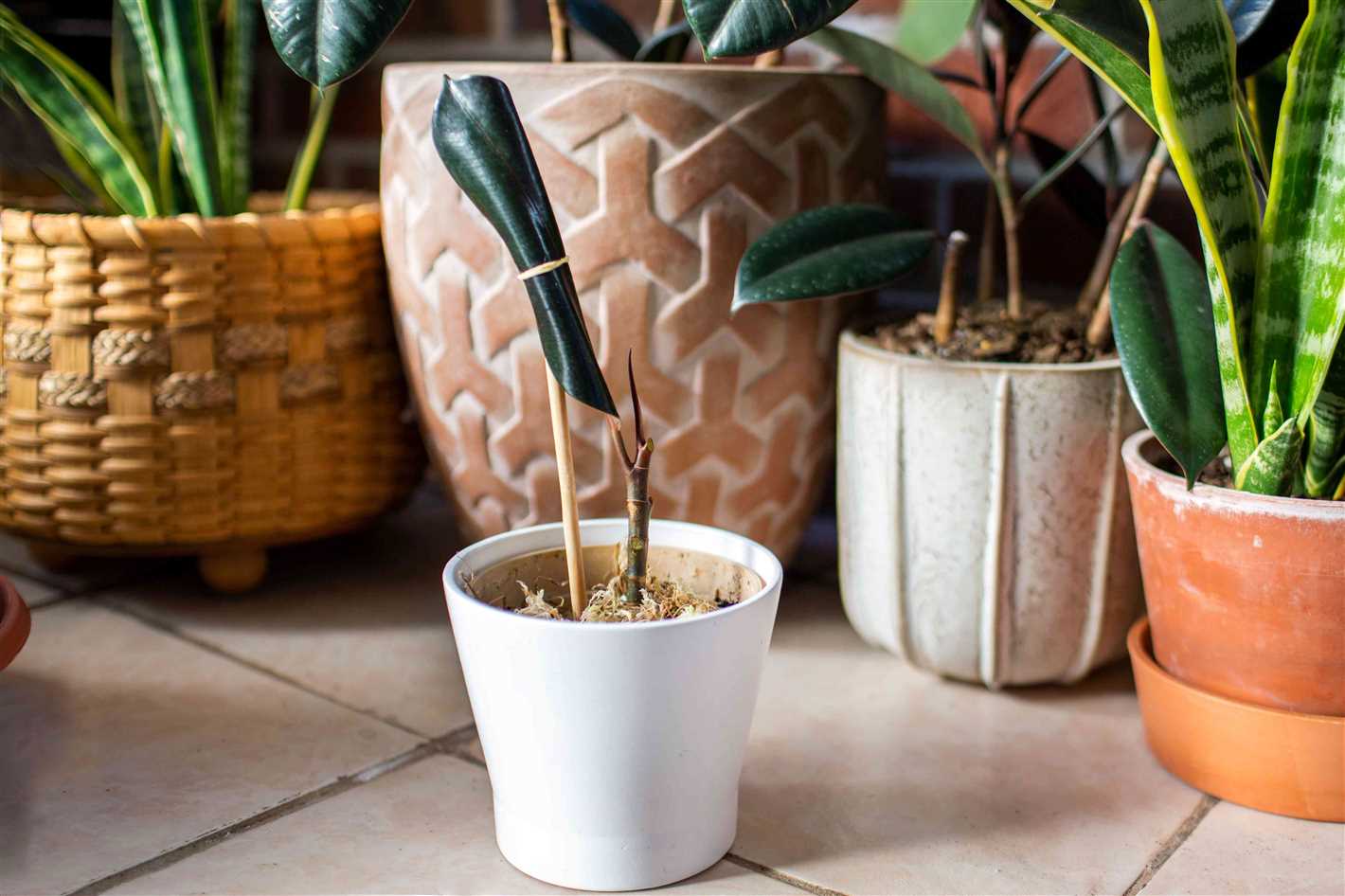- Why propagate Ficus?
- Benefits of using cuttings
- Preparing the cuttings
- Choosing the right time
- Selecting Healthy Stems
- Preparing the rooting medium
- 1. Soil-based mix:
- 2. Peat-based mix:
- 3. Propagation mix:
- 4. Water propagation:
- Rooting the cuttings
- Water propagation method
- Using rooting hormone
- Types of rooting hormone
- How to use rooting hormone
- Caring for the rooted cuttings
- 1. Transplant the cuttings
- 2. Provide proper light and temperature
- 3. Water the cuttings
- 4. Fertilize regularly
- 5. Prune as needed
- 6. Monitor for pests
- 7. Rotate the pots
- 8. Regularly monitor and adjust care
- Q&A:
- What is the best time to propagate ficus cuttings?
- How long does it take for ficus cuttings to root?
- Do I need to use rooting hormone when propagating ficus cuttings?
- Can ficus cuttings be propagated in water?
- Is it possible to propagate ficus cuttings from mature plants?
- Video: Watch Me Propagate: 18 Easy Houseplants You Can Grow for Free!

If you’re a plant lover and have always dreamed of expanding your collection of indoor plants, then ficus propagation is a great way to do it. Ficus, also known as the weeping fig, is a popular houseplant with lush green foliage and a graceful appearance. The good news is that ficus is relatively easy to propagate from cuttings, allowing you to create new plants without spending a fortune. In this article, we’ll explore the simple and fast process of ficus propagation and how you can successfully root cuttings quickly and effortlessly.
Why propagate ficus from cuttings?
Ficus propagation from cuttings is a preferred method for many plant enthusiasts because it’s a reliable and cost-effective way to create new plants. Instead of purchasing expensive potted plants, you can propagate ficus from cuttings taken from a healthy, mature plant. This way, you can ensure that the new plants have the same characteristics as the parent plant, including leaf color, size, and growth habit. Plus, it’s a gratifying experience to watch your cuttings root and grow into beautiful, mature plants.
How to propagate ficus from cuttings:
1. Select a healthy parent plant: Start by choosing a healthy ficus plant with vibrant foliage and no signs of disease or pests.
2. Take cuttings: Use clean, sharp pruning shears to take 6-8 inch stem cuttings from the parent plant. Make the cut just below a leaf node to maximize the chances of successful rooting.
3. Prepare the cuttings: Remove the lower leaves from the cutting, leaving a few leaves at the top. This reduces the water loss and directs the plant’s energy towards root development.
4. Dip in rooting hormone (optional): To enhance the rooting process, you may choose to dip the cuttings in a rooting hormone powder or gel. This stimulates root formation and increases the chances of successful propagation.
5. Plant the cuttings: Fill a small pot with a well-draining potting mix and create a hole in the center. Insert the cutting into the hole, ensuring that at least one leaf node is buried below the soil surface. Gently firm the soil around the cutting to provide stability.
6. Provide the right conditions: Place the pot in a warm, bright location with indirect sunlight. Avoid direct sunlight, as it can scorch the newly rooted cuttings. Maintain a consistent level of moisture in the soil, but be careful not to overwater, as this can cause rotting.
7. Wait for roots to develop: Over the next few weeks, monitor the cuttings for signs of root development. Once you see new growth and roots emerging from the base of the cutting, it’s an indication that the propagation was successful.
8. Pot up the new plants: Once the roots are well-established, you can carefully remove the new plants from the pot and transplant them into individual containers with fresh potting soil. Continue to provide proper care, and soon you’ll have a beautiful collection of ficus plants.
With a little patience and care, you can easily propagate ficus from cuttings and enjoy the satisfaction of growing your own plants. Whether you’re a beginner or experienced gardener, this simple and fast method of propagation is a great way to expand your green thumb and fill your space with beautiful foliage.
Why propagate Ficus?
Ficus is a popular houseplant that is cherished for its lush green leaves and easy-care nature. Many plant enthusiasts choose to propagate Ficus for various reasons:
- Expand your collection: Propagating Ficus allows you to increase the number of plants in your collection without having to buy new ones.
- Cost-effective: Instead of purchasing new Ficus plants, propagating cuttings is a cost-effective way to grow more plants.
- Preserve specific varieties: If you have a specific variety of Ficus that you love, propagating allows you to preserve and propagate that particular plant.
- Share with others: Propagating Ficus gives you the opportunity to share your love for plants with friends and family by gifting them cuttings.
- Experiential learning: Propagation is an enjoyable and educational process that allows you to learn more about plant growth and development first-hand.
With its numerous benefits, propagating Ficus is a rewarding activity for plant enthusiasts. Whether you want to expand your collection, save money, or share your love for Ficus with others, propagating cuttings is a simple and fast process that allows you to enjoy more of these beautiful plants!
Benefits of using cuttings


The process of propagating ficus plants through cuttings offers several benefits:
- Ease of propagation: Propagating ficus plants from cuttings is a straightforward and simple process that can be done by novice gardeners. It requires minimal equipment and can be completed without specialized knowledge or skills.
- Quick root development: Ficus cuttings have the ability to develop roots relatively quickly compared to other methods of propagation. Within a few weeks, you can expect to see roots starting to form, allowing you to establish new plants more rapidly.
- Higher success rate: Ficus cuttings have a higher chance of successful rooting compared to other propagation methods. This is because cuttings are taken from healthy and mature plants, which already have a well-established root system. As a result, the chances of the cutting successfully developing into a new plant are significantly increased.
- Cost-effective: Using cuttings for propagation can be a cost-effective way to expand your ficus collection or share plants with others. Instead of purchasing new plants, you can simply take cuttings from existing ones, saving money in the process.
- Genetic preservation: Propagating ficus plants through cuttings allows you to preserve the genetic traits of the parent plant. This is particularly desirable if you have a unique or rare ficus variety that you want to reproduce.
Note: While using cuttings for propagation offers many benefits, it’s important to ensure that the parent plant is healthy and free from any pests or diseases to prevent the spread of any potential issues to the new plants.
Preparing the cuttings


Propagation of ficus can be done by using stem cuttings. Before taking the cuttings, it is important to prepare the necessary tools and materials:
- Garden shears or a sharp knife for making clean cuts
- A clean, sterile container or pot for holding the cuttings
- A rooting hormone powder or gel to encourage root growth
- A suitable potting mix or soil that drains well
- A misting bottle or plastic bag to create a humid environment
Once you have gathered all the necessary items, you can proceed with taking the cuttings:
- Select a healthy branch or stem from the parent ficus plant. It should be at least 4-6 inches long and free from any signs of disease or pests.
- Make a clean cut just below a node (the point where a leaf or bud is attached to the stem).
- Remove any leaves or buds from the lower half of the cutting, leaving only a few at the top.
- If desired, dip the cut end of the stem into a rooting hormone powder or gel to stimulate root growth.
- Fill the container or pot with a well-draining potting mix or soil. Moisten the soil, but make sure it is not overly wet.
- Make a small hole in the soil and insert the cutting, ensuring that at least one node is buried in the soil.
- Press the soil gently around the cutting to secure it in place.
- If using a plastic bag, cover the pot with it to create a humid environment. Alternatively, mist the cutting with water and cover it with a clear plastic dome or plastic wrap.
- Place the cutting in a warm, bright location, away from direct sunlight.
By following these steps, you can ensure that the cuttings are properly prepared for rooting. With the right conditions and care, the cuttings should start developing roots within a few weeks.
Choosing the right time
The timing of taking ficus cuttings is crucial for successful propagation. It is best to take cuttings in the spring or early summer when the plant is actively growing and has sufficient energy to produce new roots.
Here are some factors to consider when choosing the right time to take ficus cuttings:
- Growth stage: Choose a healthy and mature ficus plant for taking cuttings. Avoid taking cuttings from stressed or unhealthy plants.
- Season: The ideal time for taking ficus cuttings is during the spring or early summer. This is when the plant is in its active growth phase and has the highest chances of successful rooting.
- Weather conditions: Choose a day with mild weather conditions, preferably with mild temperatures and low humidity. Extreme temperatures or humidity can negatively affect the success rate of rooting.
- Time of day: It is best to take ficus cuttings early in the morning when the plant’s energy reserves are at their highest. Avoid taking cuttings in the evening as the plant may be tired from the day’s activities.
By considering these factors and selecting the right time, you can increase the chances of successful ficus propagation through cuttings.
Selecting Healthy Stems
When propagating ficus cuttings, it is important to choose healthy stems. A healthy stem will have the best chance of rooting quickly and successfully. Here are some factors to consider when selecting stems for propagation:
- Mature Stems: Select stems that are semi-woody or woody, as these have a higher chance of survival compared to younger, green stems.
- No Signs of Disease or Pests: Inspect the stem for any signs of disease or pests, such as discoloration, spots, or insect infestations. Avoid selecting stems with these issues.
- No Signs of Stress: Look for stems that are not wilted, drooping, or showing signs of stress. Healthy stems should be firm and upright.
- Leaf Nodes: Choose stems that have multiple leaf nodes, as these nodes will be where the roots emerge.
- Length: Select stems that are at least 4-6 inches long, providing enough space for the roots to develop.
By carefully selecting healthy stems for ficus propagation, you can increase the chances of successful rooting and the growth of new plants. It is important to take the time to inspect and choose the best stems before proceeding with the propagation process.
Preparing the rooting medium
Before you start propagating your ficus plants through cuttings, it’s important to prepare the right rooting medium. The rooting medium provides the necessary support and nutrients for the cuttings to develop roots. Here are a few options for preparing the ideal rooting medium:
1. Soil-based mix:
A soil-based mix consists of garden soil, peat moss, and perlite or vermiculite. Mix equal parts of garden soil and peat moss, and add perlite or vermiculite to improve the drainage and aeration of the medium. This mix provides a good balance of water retention and drainage, creating a favorable environment for root development.
2. Peat-based mix:
A peat-based mix is made primarily with peat moss, which is a natural organic material that retains moisture well. Mix peat moss with vermiculite or perlite to improve drainage. This mix is lightweight, provides good water retention, and is suitable for rooting cuttings.
3. Propagation mix:
You can also use a commercial propagation mix available at gardening stores. These mixes are specifically formulated for rooting cuttings and usually contain a combination of peat moss, perlite, vermiculite, and other ingredients to provide the ideal conditions for root development.
4. Water propagation:
Instead of using a traditional rooting medium, you can also choose to propagate your ficus cuttings in water. Simply place the cuttings in a container with clean water, ensuring that the bottom nodes are submerged. Change the water every few days to prevent the growth of algae and bacteria. This method allows you to monitor root development easily and can be a fun and decorative way to propagate your ficus plants.
Regardless of the rooting medium you choose, make sure it is clean and free from any diseases or pests. Clean pots or containers before use, and consider using a sterile medium to prevent the spread of any potential pathogens.
Once you have prepared the rooting medium, you are ready to proceed with taking the ficus cuttings and initiating the propagation process.
Rooting the cuttings
Rooting ficus cuttings is a simple and efficient way to propagate new plants. Follow these steps to maximize your success:
- Start by preparing a clean propagation tray or small pots filled with well-draining potting soil. Make sure the soil is moist but not overly saturated.
- Select healthy and mature branches for cuttings. Choose branches that are at least 6-8 inches long and have several leaves. Cut the branches at a 45-degree angle just below a leaf node.
- Remove the bottom leaves of the cutting, leaving just a few at the top. This will help prevent excess moisture loss and encourage root development.
- Dip the cut end of the branch into a rooting hormone powder. This will help stimulate root growth and improve the chances of successful rooting.
- Make a small hole in the soil using a pencil or your finger. Insert the cutting into the hole, making sure the lower nodes are submerged in the soil.
- Firmly press the soil around the cutting to secure it in place. Ensure that the cutting stands upright and is not leaning to one side.
- Water the cutting thoroughly, making sure the soil is evenly moist. Avoid overwatering, as this can lead to rotting of the cutting.
- Cover the propagation tray or pots with a clear plastic bag or a plastic dome to create a humid environment. This will help retain moisture and promote root development.
- Place the cuttings in a warm and bright location, but avoid direct sunlight. A temperature of around 70-75°F (21-24°C) is ideal for root development.
- Check the cuttings regularly for signs of growth. After a few weeks, you may start to see new leaves or roots emerging from the cuttings.
- Once the cuttings have developed a healthy root system, they can be transplanted into individual pots filled with regular potting soil.
Remember to be patient and avoid the temptation to disturb the cuttings during the rooting process. With proper care and favorable conditions, your ficus cuttings should root quickly and effortlessly!
Water propagation method
Water propagation is one of the simplest and most popular methods for propagating Ficus plants. Here’s a step-by-step guide on how to propagate Ficus cuttings using the water method:
- Select a healthy Ficus cutting: Choose a 4-6 inch long cutting from a healthy Ficus plant. Make sure the cutting has at least 2-3 leaves and a node, which is a small bump on the stem where the new roots will grow.
- Prepare the cutting: Remove any leaves from the lower part of the cutting, leaving only the top 2-3 leaves. This will help prevent the cutting from rotting in water.
- Place the cutting in water: Fill a glass or jar with clean tap water and place the cutting in the water, making sure that the node is submerged.
- Provide indirect light: Place the glass or jar in a warm and bright location, but avoid direct sunlight. Ficus cuttings prefer indirect light for optimal root development.
- Change the water regularly: Every few days, replace the water in the glass or jar with fresh water to prevent the growth of algae and bacteria. This will help keep the cutting healthy and promote root development.
- Wait for rooting: It typically takes 2-4 weeks for the Ficus cutting to develop roots. You will start to see small white roots growing from the node of the cutting.
- Transplant the cutting: Once the roots are about 1-2 inches long, you can transplant the cutting into a well-draining potting mix. Make a small hole in the soil and gently place the cutting, covering the roots with soil. Water the soil lightly to settle it around the cutting.
- Care for the new plant: After transplanting, place the newly rooted Ficus in a location with bright, indirect light. Water it regularly, keeping the soil lightly moist but not soggy. Gradually increase the amount of sunlight the plant receives to acclimate it to its new environment.
Using the water propagation method for Ficus cuttings is an easy and effective way to propagate these popular houseplants. Give it a try and enjoy expanding your Ficus collection!
Using rooting hormone
Rooting hormone is a substance that promotes the growth of new roots on plant cuttings. It contains auxins, which are naturally occurring plant hormones that stimulate root development.
Using rooting hormone can significantly increase the success rate of ficus cuttings, as it provides an extra boost of hormones to encourage root growth.
Types of rooting hormone
There are different types of rooting hormone available on the market:
- Powder: This is the most common form of rooting hormone. It is easy to use and can be applied directly to the cut end of the cutting.
- Gel: Rooting hormone gel has a sticky consistency, making it easier to apply and adhere to the cutting.
- Liquid: Liquid rooting hormone is diluted in water and can be used for soaking the cuttings or applying directly to the cutting with a brush or sponge.
How to use rooting hormone
To use rooting hormone on ficus cuttings, follow these steps:
- Take a clean and sharp pair of pruners and make a clean cut just below a leaf node on the cutting.
- Dip the cut end of the cutting into the rooting hormone, ensuring that it is evenly coated.
- Gently tap off any excess hormone powder or gel.
- Plant the cutting in a pot filled with well-draining soil or a rooting medium.
- Water the cutting well and place it in a warm and humid environment, away from direct sunlight.
- Monitor the cutting for signs of new growth and root development.
Using rooting hormone can give your ficus cuttings a head start in rooting, increasing the chances of successful propagation. However, it is important to remember that rooting hormone is not essential and many ficus cuttings will root successfully without it.
Caring for the rooted cuttings
Once your ficus cuttings have successfully rooted and are ready to be cared for, there are a few important steps you should follow to ensure their continued growth and health.
1. Transplant the cuttings


After the roots have developed, it is important to transplant the cuttings into individual pots or a larger container, depending on the size of the root system. Use a well-draining potting soil to promote healthy growth.
2. Provide proper light and temperature
Ficus plants thrive in bright, indirect light. Place your rooted cuttings in a location where they can receive ample sunlight without being exposed to direct sunlight, as this can cause leaf scorch. Maintain a temperature range between 60°F (15°C) and 75°F (24°C) for optimal growth.
3. Water the cuttings
Keep the soil consistently moist but not waterlogged. Water the cuttings whenever the top inch of soil feels dry to the touch. Avoid overwatering, as this can lead to root rot. Mist the leaves occasionally to increase humidity, especially in dry indoor environments.
4. Fertilize regularly
Feed your ficus cuttings with a balanced liquid fertilizer during the growing season, which is typically from spring to early fall. Follow the instructions on the fertilizer package for the recommended dosage and frequency of application. This will provide the necessary nutrients for healthy growth.
5. Prune as needed


As your ficus cuttings grow, you may need to prune them to maintain their shape and control their size. Pruning can also encourage branching and create a fuller, bushier plant. Use clean, sharp pruning shears and make cuts just above a leaf node or bud.
6. Monitor for pests
Keep an eye out for common pests such as aphids, mealybugs, and spider mites. If you notice any signs of infestation, such as discolored leaves or webbing, take immediate action to treat the affected plants. Use organic insecticides or natural remedies, and regularly inspect your ficus cuttings to prevent widespread damage.
7. Rotate the pots
To ensure even growth and prevent your ficus cuttings from leaning towards the light source, rotate the pots by a quarter turn every few weeks. This will help promote balanced growth and prevent the plants from becoming lopsided.
8. Regularly monitor and adjust care
Keep a close eye on your ficus cuttings and regularly monitor their growth, watering needs, and overall health. Adjust your care routine as necessary to accommodate any changes or specific requirements that may arise. With proper care and attention, your rooted cuttings will continue to thrive and mature into beautiful ficus plants.
Q&A:
What is the best time to propagate ficus cuttings?
The best time to propagate ficus cuttings is during the spring or early summer when the plant is actively growing.
How long does it take for ficus cuttings to root?
Ficus cuttings usually root within 4-6 weeks, although some varieties may root even faster.
Do I need to use rooting hormone when propagating ficus cuttings?
While using rooting hormone can speed up the rooting process, it is not necessary for propagating ficus cuttings. They can root successfully without it.
Can ficus cuttings be propagated in water?
Yes, ficus cuttings can be propagated in water. Simply place the cuttings in a container of water and change the water every few days to prevent rotting. Once roots have developed, the cuttings can be planted in soil.
Is it possible to propagate ficus cuttings from mature plants?
Yes, it is possible to propagate ficus cuttings from mature plants. However, cuttings taken from younger plants tend to root more quickly and successfully.
Video:
Watch Me Propagate: 18 Easy Houseplants You Can Grow for Free!







